Linear French Drains – A Gutter in the Ground
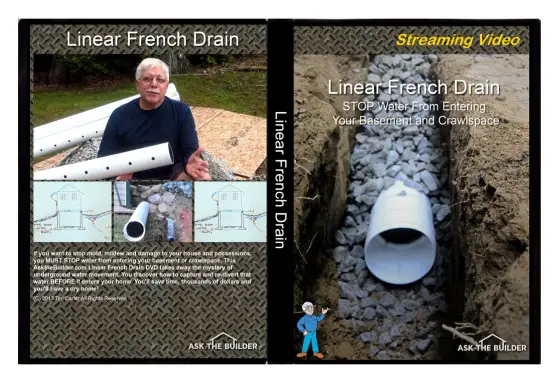
Do your own DIY install of a Linear French Drain with Tim Carter's time-tested methods and materials! CLICK IMAGE TO ORDER NOW!
Linear French Drains - They Work Well - Read the Testimonials
The Testimonials are in Author's Notes below!
DEAR TIM: We've lived in our home for twenty-two years. Our basement has always been dry. However, this winter water began to enter our basement along our front wall. There are no cracks in the foundation wall and the water company indicates that our water line is not leaking. What has happened? Is there a way to either stop or control the water? By the way, what do you think of the new raised bed landscaping in the photos? C.H.
DEAR C. H.: Your landscaping looks great, for now. I suggest you go out and enjoy it before your landscaper comes back out and temporarily removes it. The landscaping activity is the root of your problem. Several things may have happened.
Does Raised Landscaping Cause Wet Basements?
Yes, raised landscaping beds cause wet basements because the water flows towards the house instead of away from it. Water is supposed to drain away from a house. The soil around a foundation should slope down 6 inches in the first 10 feet of horizontal distance away from the foundation. Look at the green line below in my illustration.
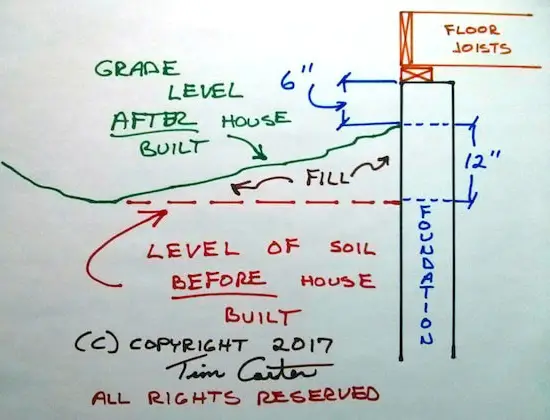
The photos you sent me clearly indicate a problem which your landscaper created. The extra soil which was brought to your home to create the raised beds has created a negative slope situation on the front of your home. Prior to the landscaping, the ground sloped away from the front of your home. Now the ground slopes back towards your house. This condition is often referred to as a negative slope or pitch.

Remember, the holes in the perforated pipe point down. If they point up, they get clogged by pieces of gravel.
What Causes Most Basement or Crawlspace Drainage Problems?
Negative slope and roof water dumping next to a foundation cause a majority of basement or crawlspace drainage problems. It can also cause problems for houses built on slabs. Houses built on hillsides often are victims of negative slopes, as the ground uphill from the house directs surface and groundwater directly at the structure.
CLICK or TAP HERE to get FREE BIDS from local contractors who can install your linear french drain.
Can Broken Buried Drain Lines Cause Wet Basements?
Yes, a cracked or leaking buried drain line can cause water to leak into the soil next to a basement wall.
Two other things could have happened as well. The landscaper could have accidentally broken an underground downspout line while digging. Every time it rains water could be saturating the soil against your foundation. Landscapers sometimes till the soil before they plant. This tilling activity fluffs the soil which makes it soak up water more readily.
How Do You Correct Negative Soil Slope?
In those areas where the landscaper has created a negative slope, remove whatever dirt is necessary to create a positive slope away from your house. If your foundation is high enough out of the ground, you can actually add dirt to create the same effect. However, always try to leave a minimum of 6 inches of foundation exposed. Study the illustration above.
Will a Linear French Drain Stop Basement Leaks?
A linear french drain in the soil will stop basement leaks. My college degree is in geology with a focus on groundwater. I've solved thousands of wet basement problems just like yours with a simple 30-minute phone call.
What is a Linear French Drain?
A linear french drain is a hidden piping and drainage system that captures subsurface water before it enters your house. It works just like a gutter on a roof. Water flowing down a roof falls into a gutter and this water is then diverted into a pipe. The pipe is extended away from your house so the rainwater can flow naturally down to the ocean the way it did before your home got in the way.
Do Linear French Drains Really Work?
Yes, they work exceptionally well. I installed this system on my own property with great success. Water moves sideways through the soil. It moves through the air spaces in the topsoil. Most subsoils are dense clay and the water flowing through the soil moves across the top of the subsoil.
A linear french drain takes advantage of this dynamic. The moving water encounters the gravel in the trench and flows down to the perforated pipe instead of continuing its journey through the soil until such time as it bubbles into a small creek near your home.
Can You Call Me on the Phone to Help Me?
Yes, I can call you on the phone to help you solve your wet basement problem. I've done hundreds of calls with homeowners like you and solved each problem. The calls always are 30 minutes or a little less. I record the call and send you the MP3 file so you don't have to take notes during the call. You send me photos of your yard or a short video, and then I draw a picture for you showing how to install the linear french drain. Read Jim's testimonial below to see how I helped him.
Most recent customers to order a phone consult: Manu, Alexandria, VA | Patti, Ft. Worth, TX | Warren, Hamilton, OH | Sandra, Bend, OR | Brandon, Rapid City, SD | Alice, Plant City, FL | Loreli, Worcester, MA
My neighbor's property sits higher than mine. In the spring, the soil is so saturated that an underground river of water flows through the soil towards my house.
I controlled the water by digging a 6-inch-wide trench 24 inches deep along the entire length of the problem area. I installed 1 or 2 inches of washed 1-inch gravel in the bottom of the trench. Then I installed a 4-inch perforated drain pipe in the trench. I prefer to use a white plastic pipe that has two or three rows of holes drilled in the pipe at 8-inch centers. Be sure to install the pipe with the holes pointing DOWN. If they point up, small pieces of gravel can close off the holes and water can't get into the pipe.
How High Should the Gravel be in the Linear French Drain?
I prefer to fill the trench to the top with gravel. If you don't like the look of the gravel in your yard, then stop about 1.5 inches from the top and put in a piece of sod.
Should I Line the Trench with Filter Fabric?
Never use filter fabric in a linear french drain. Any silt flowing through the soil, and this rarely happens by the way, can clog the filter fabric and water then can't enter the linear french drain.
Filter fabric products are designed to stop the movement of the silt. If the fabric gets clogged with silt, then water can't find its way into the trench or the pipe.
Because my lot slopes front to back, I constructed the trench so that it sloped at a shallower angle than my lot. The drainpipe actually comes out of the ground at the rear of my property. All of the water which used to come towards my house hits this linear French drain. Because water usually takes the path of least resistance, it drops through the gravel and then takes a white water ride through the pipe to the rear of my yard. Most yards have enough slope to make this system work very effectively.
Author's Notes:
October 1999
Do you wonder if linear French drains really work? Read an e-mail I received from Pat Jones in Vienna, Virginia:
A year ago last spring, I called your radio show from my home in Vienna, VA. I described my problem with water in my basement. It was very predictable, every time it rained 2" or more in 24 hours I would get water in my basement. Anyway, you advised me that a French drain would solve my problem.
So I rented the ditch witch and got a bunch of friends, following your on-line tips we installed the drain. Your tip about the plywood to have the dirt flow onto was a great labor saver. We did have a lot of trouble with rocks and tree roots stalling the machine but in the end it was a job well done.
Of course, our work and your advice caused the drought in the Washington, DC area. We waited almost a year and a half before we got to really test the French drain. However when hurricane Floyd came through and gave us 4" in less than a day and the basement was high and dry I figured it was worth the drought. Now the neighbors are asking my advice, and I point them to your web page.
When we talked you said to let you know how it worked out. It worked out great!!
Thank you very much,
Patrick Jones
November 2003
Some wonder if you need to add a straw layer on top of the gravel. It's not necessary if you fill the entire trench with gravel to within one inch of the top. The reason is simple: Silt does not pass sideways through the topsoil. The silt that turns stormwater runoff brown is eroded soil particles that are running in overland flow.
Silt particles get trapped and filtered in the upper layers of topsoil. The vast amount of water captured by a linear French drain is water traveling sideways through the soil. It's generally clear and free of silt. To prove this point, spring water and water taken from underground wells is almost always crystal clear. The silt was left behind at the surface as the water was entering the ground.
Tim Carter
Author's Notes:
You may wonder if my advice is worth anything. Well, read the long summary of what Jim Sanders wrote to me when he was at the end of his rope. My advice in the above column saved him:
"Hi, I just wanted to write to give you the results of my "Trench Drain".
The 30 minutes you spent with me on the phone were the best investment I've ever made. You'll see why when you read what happened after I followed your advice.
I've had a wet crawlspace for 15 years. Water would fill the crawlspace at times, so we actually had to drill weep holes at the base so that it would enter the basement and eventually, the sump pump.
I have tried everything. Several contractors said that the only thing we could do was to bring the water into the house via drainage tile and let it enter the sump pump. That would work, but because I live on a 6' elevation, there is no reason that I should have water problems. It became like clockwork...when it rained, we would rush home from the lake or wherever we were vacationing so that we could be prepared to start the backup generator, in case the power failed. We even had our alarm company put a sump alarm on our system, so they could notify us if we had a power failure. Battery backup was not an option, because sometimes we lose power for days, and during any rain, our sump would run every 7 minutes...just like clockwork.
I found your site and read your above article on the trench or French drain. At first, it sounded a bit like "holistic healing" to me. I failed to understand why a 2 ft. deep trench, 4 ft. away from the house would do any good. How could this simple thing correct an extreme water problem that has plagued me for years, cracked my foundation, settled my garage floor, and ruined almost every vacation?
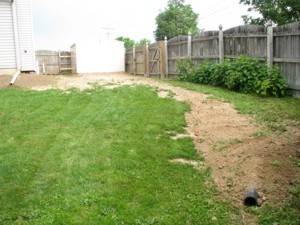
The Linear French Drain trench running from the house. PHOTO CREDIT: Jim Sanders
I decided "what the heck". I had to dig by hand using a trenching spade and a pick-ax because the builder back-filled our property with brick and blacktop. It took quite a bit of time. Because the ground level varies so much on that side of the house, I was not able to achieve exactly 2 ft. deep. It varied from 18" to 30" in spots, but the slope was downhill. The trench is about 80 ft. long. At times, I thought about filling it all in, because I just didn’t believe that it would work.
I stoned it, put tile in, and filled it with #1 round stone. I socked the pipe just for safety measure, and I also used geo-textile fabric on top, so I could cover with dirt and grass. I also ordered some clay and pitched from the house to the drain. (Tim Carter Note: Do NOT put a sock on the pipe and DO NOT USE a geotextile fabric as Jim did!)
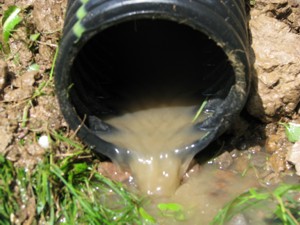
After a short rain, water is running away from the house. PHOTO CREDIT: Jim Sanders
Result? For the last month, we have had seven or eight torrential rains, the worst of which was last night. It rained so hard, that our lawn washed out in spots because of the high clay content. Our sump pump, which normally ran every 7 minutes during and after rain, has not turned on for 4 weeks. The silt at the bottom of the sump well is now dry and cracking. Our crawlspace has not shown a trace of water or even moisture.
Since I couldn’t see correcting the foundation cracks or the garage floor settling and tilting until I corrected the problem's source, I waited to see if the trench drain worked first.
This week, I had a company come in and perform sort of a "mud-jacking" technique on the garage floor, which worked perfectly. Also, during the past few weeks, I parged the cracks in the foundation.
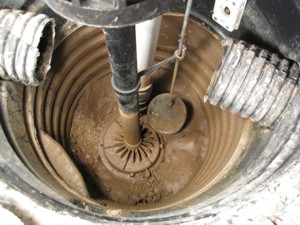
A dry sump pump. PHOTO CREDIT: Jim Sanders
I just wanted you to know how this worked. I stressed for many years over this issue and the solution was nowhere near as difficult as I thought it would be.
As a side note, I went to the end of the drain tile during a hard rain to see what was happening. Water was running out of the drain tile in about the same exact volume that it previously ran out of the weep holes in my crawlspace. This winter will be interesting, because last year, the ground next to the house was so saturated that during a thaw, my sump would run constantly. I'm guessing that the ground between the trench and the house will probably be drier now going into this winter."
- Jim Sanders, Upstate area - New York
CLICK HERE to get FREE & FAST BIDS from local drainage expert contractors.
Column 070
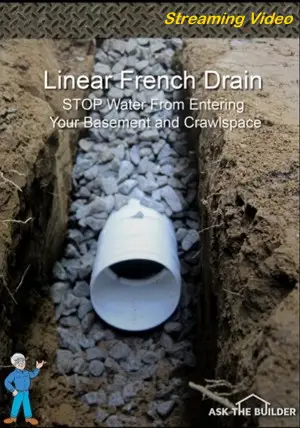
One Response to Linear French Drains – A Gutter in the Ground